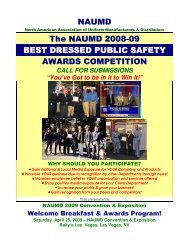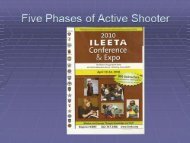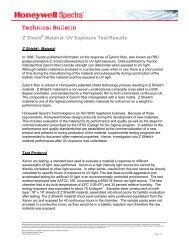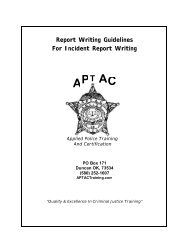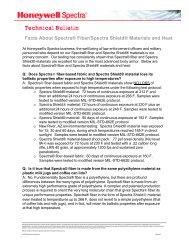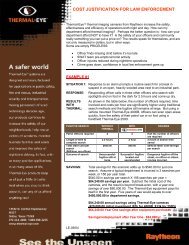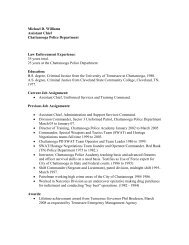The National Vehicle Location Service
The National Vehicle Location Service
The National Vehicle Location Service
Create successful ePaper yourself
Turn your PDF publications into a flip-book with our unique Google optimized e-Paper software.
<strong>The</strong> Information Source For<br />
Law Enforcement And Homeland Security<br />
SEPTEMBER/OCTOBER 2010 PUBLISHED BY DAYS COMMUNICATIONS, INC. VOL. 26 ISSUE 5<br />
Stolen vehicles, felony wants, and Amber alerts are all compelling<br />
reasons to adopt automated License Plate Reader (LPR)<br />
technology. Patrol officers can quickly and easily download critical<br />
information for traffic stops or calls for service, enhancing both<br />
their own and the public’s safety.<br />
However, for the technology to become a strategic part of<br />
interoperability efforts among North American federal, state, and<br />
local Law Enforcement Agencies (LEAs), a shared LPR historical<br />
database must be in use and it must be available to every agency –<br />
regardless of whether they have their own LPR systems.<br />
A large, centralized, geographically diverse shared LPR database,<br />
which receives tens of millions of new vehicle locations each<br />
month, is a resource many police departments have only dreamed<br />
of; yet, Vigilant Video Inc., together with <strong>National</strong> <strong>Vehicle</strong> <strong>Service</strong><br />
(NVS, ORI #VANVS005V), has made this high-tech intelligence<br />
tool a reality – for free.
A typical data intelligence report<br />
of a stolen vehicle from Los Angeles<br />
Serving the Public Good<br />
Since the <strong>National</strong> <strong>Vehicle</strong> <strong>Location</strong> <strong>Service</strong> (NVLS) Web portal<br />
(http://nvls-lpr.com/nvls) launched in the second quarter of<br />
2010, hundreds of local, state, and federal LEAs have signed on.<br />
<strong>The</strong> database isn’t just for agencies with existing automated<br />
LPR systems which hope to host their LPR data in a secure national<br />
sharing repository. Instead, the NVLS provides all agencies<br />
with access. Participating agencies can not only opt to just share<br />
each other’s public LPR data, but they may also opt for access to<br />
Vigilant Video’s ever growing national private LPR database.<br />
<strong>The</strong> NVLS database contains over 185 million vehicle location<br />
records and more than 23 million new locations are added<br />
each month. <strong>The</strong> database’s overwhelming intelligence value motivated<br />
Vigilant Video (through NVS) to rapidly enable no cost<br />
distribution of vehicle location searches via direct law enforcement<br />
Nlets queries. Perhaps most importantly, the <strong>National</strong> Center<br />
for Missing and Exploited Children (NCMEC) has access,<br />
enabling NCMEC agents to utilize the database while investigating<br />
their cases.<br />
As Vigilant Video’s Vice President of Sales and Marketing,<br />
Joe Harzewski, puts it, “NVLS as a national security asset has wins<br />
across the entire United States. With most every federal agency<br />
and most large metro area law enforcement agencies participating<br />
as NVLS members, we are supporting thousands of vehicle location<br />
searches every month which have resulted in hundreds of<br />
arrests, or an apprehension rate of between 40 and 80 percent,<br />
Page 2<br />
depending on the LEA’s speed in responding to the data. <strong>The</strong> most<br />
exciting part is that NVLS has only just begun to scratch the surface<br />
of public good.”<br />
Where the Private Data Come From<br />
Private LPR data come from thousands of vehicles, or “spotter<br />
cars,” equipped with LPR cameras used by LPR Fleet Operators<br />
(LFOs). LFOs gather vehicle license plate data anywhere vehicles<br />
can reasonably be expected to remain for some time or return in<br />
the future. (Conversely, LEAs collect license plate data which, to<br />
a large extent, corresponds to vehicles in transit and may not be of<br />
high forensic intelligence value.) Vigilant Video’s business supports<br />
LFOs with software, hardware, and mapping systems, all of<br />
which expedite the data collection process by showing LFOs when,<br />
and where, to collect data.<br />
Vigilant Video’s private LPR database boasts 185 million plus<br />
records from vehicles nationwide. Vigilant currently adds more<br />
than 23 million private LPR records per month to its database. By<br />
the end of 2010, the company expects to attain a new data add rate<br />
of more than 30 million records per month, for a total of 200 million<br />
additional records added during CY 2010, all of which flow<br />
into the database in a real-time, constantly updating stream.<br />
Accessing the Data<br />
Both public and private LPR data are distributed through Nlets,<br />
but may also be accessed on-line via the NVLS Web portal. <strong>The</strong><br />
means for granting access comes from a sophisticated registration<br />
process, whereby NVLS administrative personnel validate each<br />
LEA user applicant. Each valid NVLS user account is then synchronized<br />
with Vigilant’s proprietary Law Enforcement Archival<br />
Reporting Network (LEARN-NVLS) so that users can look up<br />
applicable location data via the NVLS Web portal.<br />
LEARN-NVLS manages three key categories of LPR related<br />
data:<br />
1. Detection records – <strong>The</strong>se are records obtained from LPR<br />
equipped vehicles. <strong>The</strong>y include the following attributes: color<br />
overview image; IR license plate image; license plate Optical Character<br />
Recognition (OCR) result; date/time stamp; location data;<br />
camera/system information; user information; and nearest address.<br />
2. Hot lists – <strong>The</strong>se are “vehicles of interest” and contain<br />
license plate number source files, associated vehicle data, and<br />
alert types.<br />
3. Hit records – <strong>The</strong>se are detection records matched with<br />
applicable hot list records.<br />
<strong>The</strong> database itself, together with the NVLS plate lookup portal<br />
and the LEARN-NVLS LPR database end user Web interface,<br />
is hosted within a highly secure Northern Virginia data<br />
center facility.<br />
Scalable Information Sharing<br />
Participating LEAs with automated LPR systems are encouraged<br />
to leverage NVLS to share their LPR data, although they do<br />
not have to in order to attain an NVLS user account. However,<br />
because LEARN-NVLS allows law enforcement agencies their own<br />
data storage, they do not have to maintain their own LPR data<br />
ecosystem or storage infrastructure which can be costly – both up<br />
front and over time.<br />
Data are maintained via agency accounts which include unlimited<br />
users’ accounts, along with an administrator’s account. This is<br />
used to manage technical maintenance and user information including<br />
permission. Permission includes the rights to view and edit<br />
data; e.g., detections, hits, hot lists, mapping utilities, and data
Stolen vehicle locations<br />
based on three weeks of reported data<br />
mining tools. All of these aspects ensure that transaction accountability<br />
is maintained per NCIC requirements.<br />
Agencies which do host LPR data within LEARN-NVLS are<br />
solely responsible for determining how their data are accessed and<br />
(if they desire) shared. In fact, participating LEAs can even determine<br />
how long their data will be stored on the LEARN-NVLS<br />
server before it is archived or deleted.<br />
From here, law enforcement agencies can choose to share data<br />
with only certain designated NVLS participants or with all other<br />
valid LEARN-NVLS LEA entities. <strong>The</strong> database, built on<br />
Microsoft ® ’s SQL Enterprise, allows for fast queries, less network<br />
traffic, and no server “nodes” on which many other information<br />
sharing schemes rely.<br />
Vigilant Video’s LPR systems were specially designed with in<br />
vehicle plug and play network technology to allow for national<br />
LPR data sharing and to enable live, real-time network-based hot<br />
list synchronization with national databases. <strong>The</strong> Vigilant in car<br />
LPR application is so advanced that one officer can add a hot<br />
plate and, moments later, have that hot plate on a live department<br />
(or even nationwide) LEA watch list which is accessible to US<br />
investigators who may assist in locating the hot listed vehicles.<br />
From Data to Results<br />
<strong>The</strong> success of NVLS and Vigilant Video’s national LPR data<br />
server remains unparalleled. Almost daily, the NVLS administration<br />
receives voluntary success stories highlighting results of this<br />
new and innovative approach to LEA practices.<br />
• Houston, TX – “A hit-and-run homicide vehicle was spotted<br />
by the NVLS system. Hours later, the perpetrator was apprehended<br />
at a pay by the month, extended stay hotel.”<br />
• Chicago, IL – “An armed robbery occurred and witnesses<br />
noted the license plate on the fleeing vehicle; the NVLS historical<br />
database located the perpetrator’s residence, resulting in apprehension<br />
a few hours later.”<br />
• Sacramento, CA – “Our unit just recently located two vehicles<br />
under cargo theft investigation which were found at the reported<br />
NVLS locations.”<br />
• Phoenix, AZ – “Our bomb squad has verified that our target<br />
vehicle is in Austin as of last night.”<br />
• Scottsdale, AZ – “We have found two different shooting suspects<br />
and an armed robbery suspect based on the history which the<br />
NVLS Web site provided us.”<br />
• State of MD – “In less than ten minutes of signing up for the<br />
NVLS service and running my first tag, I received information on<br />
a critical lead in a case for one of my subordinates.”<br />
• Bellevue, WA – “In June, patrol officers responded to a residential<br />
burglary. A witness provided a license plate of a fleeing<br />
suspect. A registration query via Nlets led to the information in<br />
NVLS.”<br />
• Fairfax, VA – “Within the first two weeks of using the NVLS<br />
database, we recovered three stolen vehicles – one of which led to<br />
a large amount of stolen property, including iPod ® s, GPS units,<br />
credit cards, and other electronics.”<br />
About the Author: Christa M. Miller (http://christammiller.com)<br />
is a freelance writer and public relations consultant based in South<br />
Carolina. She specializes in law enforcement and digital forensics<br />
issues.<br />
Page 3





